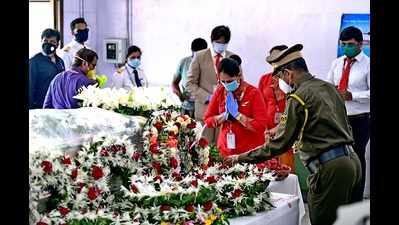- News
- City News
- mumbai News
- Two hours before AI crash, a plane landed similarly, but safely
Trending
This story is from August 10, 2020
Two hours before AI crash, a plane landed similarly, but safely
Less than two hours before the Air India Express flight from Dubai landed and crashed, an IndiGo flight had followed a similar approach and landing onto the Calicut runway on Friday evening. The difference though, was that the IndiGo flight was operated with an ATR, a turbo prop aircraft, which operates at much lower speeds than the jet-engined Boeing 737s.

Colleagues pay tribute in Mumbai on Sunday to Capt Deepak Sathe, commander of AI Express plane that crashed in Kozhikode on Friday (Photo: Uma Kadam)
MUMBAI: Less than two hours before the Air India Express flight from Dubai landed and crashed, an IndiGo flight had followed a similar approach and landing onto the Calicut runway on Friday evening.
The difference though, was that the IndiGo flight was operated with an ATR, a turbo prop aircraft, which operates at much lower speeds than the jet-engined Boeing 737s.
ATR aircraft typically carry out an approach to land at 110-115 kts, as against Boeing 737s, which would have an approach speed of about 140-150kts.Slower the speed of the aircraft, shorter the runway length it needs to cover to come to a halt.
But the IndiGo aircraft had followed a similar flight profile, said Capt Amit Singh, an air safety expert. He relied on data from flightradar24, a live flight-tracking website, which showed that the pilots too had initially lined up to land on the westerly runway 28, like the AI pilots, as this was the runway with headwinds that are favourable for landing. But the IndiGo pilots discontinued the approach to land, which could have been for similar reasons, poor visibility due to rains and cloud cover.
The difference though, was that the IndiGo flight was operated with an ATR, a turbo prop aircraft, which operates at much lower speeds than the jet-engined Boeing 737s.
ATR aircraft typically carry out an approach to land at 110-115 kts, as against Boeing 737s, which would have an approach speed of about 140-150kts.Slower the speed of the aircraft, shorter the runway length it needs to cover to come to a halt.
But the IndiGo aircraft had followed a similar flight profile, said Capt Amit Singh, an air safety expert. He relied on data from flightradar24, a live flight-tracking website, which showed that the pilots too had initially lined up to land on the westerly runway 28, like the AI pilots, as this was the runway with headwinds that are favourable for landing. But the IndiGo pilots discontinued the approach to land, which could have been for similar reasons, poor visibility due to rains and cloud cover.
“The IndiGo pilots then made a second attempt and landed on the easterly runway 10, same as the Air India Express pilots,” said Capt Singh. “The IndiGo ATR may have faced less severe weather and the slower turboprop aircraft may have been more forgiving. Nevertheless, this pattern can provide some interesting insights into the prevailing conditions and the interactions between the pilots and the air traffic controller,” he added.
End of Article
FOLLOW US ON SOCIAL MEDIA










